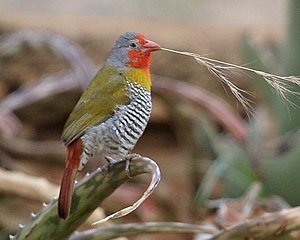Buntastrild
| Buntastrild | ||||||||||||
|---|---|---|---|---|---|---|---|---|---|---|---|---|

Great red deer ( Pytilia melba ) |
||||||||||||
| Systematics | ||||||||||||
|
||||||||||||
| Scientific name | ||||||||||||
| Pytilia melba | ||||||||||||
| ( Linnaeus , 1758) |
The red deer ( Pytilia melba ) is a species of bird in the finch family from tropical Africa south of the Sahara . For this bird, which was first placed in the genus Fringila , numerous subspecies have been described in addition to the nominate form , of which nine are currently recognized:
- Pytilia melba citerior Strickland, 1853
- Pytilia melba soudanensis (Sharpe, 1890)
- Pytilia melba belli Ogilvie-Grant, 1907
- Pytilia melba jessei Shelley, 1903
- Pytilia melba grotei Reichenow, 1919
- Pytilia melba hygrophila Irwin & Benson, 1967
- Pytilia melba flavicaudata Welch & Welch, 1988
- Pytilia melba thamnophila Clancey, 1957
- Pytilia melba percivali Someren, 1919
description
Buntastrilde reach a body length of twelve to 13 centimeters. The red beak and the red face mask are striking. Starting from the base of the beak, a narrow band runs over the eyes to the neck and forms a large patch on the neck. The chest and the wing coverts are olive green. The underside is blocked . Females are colored similarly to males, but they lack the red face mask. The singing is gurgling and whistling. The subspecies of the Buntastrild are divided into a red-bridled and a gray-bridled subspecies group depending on the size of the red face mask.
distribution and habitat
The habitat of the Buntastrild are the drier savannahs and bush areas of Africa. The species is absent in the rainforest region of West and Central Africa as well as in the humid savannahs adjacent to it to the north and in the highlands of Ethiopia . The red-lined subspecies inhabit the northern part of the distribution area. They are distributed from Senegal through Sudan and northern Kenya to the East African coast. The gray-bridled subspecies group occurs in the southern part of Africa. Their distribution area extends in the north to the interior of Kenya and Uganda . Isolated by a distribution area of red-lined forms, gray-lined sparrows are also found in Eritrea . Compared to the Wienerastrild , which belongs to the same genus, Buntastrilde prefer drier terrain. They live mainly in dense thorn bushes.
The diet consists mainly of grass seeds and insects. At times, Buntastrilde mainly live on termites. They are less sociable than other fine finches and can usually only be seen in pairs. Small family groups can only be observed at the end of the breeding season. Buntastrilde are free breeders. The nesting material consists of grass, coconut fibers and feathers. The female lays four to six eggs. Clutches that contain seven eggs are clutches in which brood parasitic widow birds of the genus Vidua have added an egg. The incubation period is twelve to 13 days. Both parent birds breed. The young birds leave the nest after 21 days. The breeding season varies depending on the distribution area, but usually falls in the second half of the rainy season and extends into the dry season. In contrast to this, the breeding season in southern Africa falls at the end of summer and the beginning of southern winter.
attitude
Buntastrilde are one of the magnificent finches that were imported into Europe very early on. In smaller numbers, they were introduced several times in Germany in the 1870s and found their way into the collection of the later Ferdinand of Bulgaria . The Buntastrild has been offered regularly in the bird trade since 1953. He is only bred by a few breeders. Most of the Buntastrilden in trade are wild-caught, most of which arrive in Europe in a very poor state of health. Buntastrilde are unsuitable for keeping in cages. You need a spacious indoor aviary, which is followed by a densely planted outdoor aviary. Great tribes are aggressive birds and can only be kept with other bird species in larger aviaries. It has been shown that Buntastrilde are very aggressive towards the closely related Wienerastrild , which also has a red face mask.
supporting documents
literature
- Horst Bielfeld : Knowing and caring for 300 ornamental birds. Ulmer Verlag, Stuttgart 2009, ISBN 978-3-8001-5737-2 .
- Peter Clement, Alan Harris, John Davis: Finches and Sparrows - An Identification Guide , Christopher Helm, London 1993, ISBN 0-7136-8017-2
- Jürgen Nicolai (Ed.), Joachim Steinbacher (Ed.), Renate van den Elzen, Gerhard Hofmann, Claudia Mettke-Hofmann: Prachtfinken - Afrika , Series Handbuch der Vogelpflege, Eugen Ulmer Verlag, Stuttgart 2007, ISBN 978-3-8001- 4964-3
Web links
- Videos, photos and sound recordings of Pytilia melba in the Internet Bird Collection
- Buntastrild on AVIBASE
- BirdLife factsheet on Buntastrild
- Pytilia melba inthe IUCN 2013 Red List of Threatened Species . Listed by: BirdLife International, 2012. Retrieved November 23, 2013.
